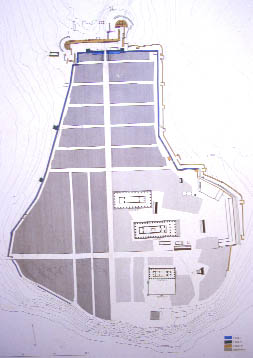

There were undoubtedly other temples on this hill which were destroyed in antiquity, but their foundation platforms may exist.
 |
|||||||||||||
|
|
|||||||||||||
| ravdmeer@telekabel.nl | |||||||||||||
|
|
|||||||||||||
| Selinunte (Greek Selinus) was colonised from Megara Hyblaea, probably as early as 651 B.C. It takes its name from the wild celery (Greek selinon), which still grows here in abundance. Its most prosperous period was the 5C B.C., when the great temples were built, and the city was laid out on a rectangular plan. After the battle of Himera Selinunte allied itself with Syracuse against Carthage, and in 409 B.C. the Carthaginians, summoned to the help of Segesta, the mortal enemy of Selinunte, sent an army of 100,000 under Hannibal, son of Gisco, which took Selinunte by assault before the allied troops of Agrigentum and Syracuse could arive. The city was sacked and destroyed, and a later settlement led by Hermocrates, a Syracusan exile, was dipersed by Carthage in 250, and the population resettled at Lilybeaum. It is thought, however, that the utter destruction of every building, scarcely a single column being left upright, must have been due to earthquakes, rather than to the hand of man. | |||||||||||||
|
|
|||||||||||||
| The temples are distinguished by letters as their dedications are still under discussion. They were the only temples in Sicily to be decorated with sculptures; many of their beautiful metopes are displayed in the archaeological museum in Palermo. All except Temples B and G are peripteral and hexastyle and all are orientated. The measurements given refer to the temple stylobates. Many architectural fragments bear remains of intonaco (plaster), and throughout the site are underground cisterns, built to collect rainwater. Beside most of the temples are sacrificial altars. | |||||||||||||
|
|
|||||||||||||
| The Acropolis |  |
||||||||||||
| In the first years of the colony a number of altars and small sanctuaries were set up on the acropolis hill, but about fifty years later these began to be replaced by larger and more permanent ones.
There were undoubtedly other temples on this hill which were destroyed in antiquity, but their foundation platforms may exist. |
|||||||||||||
|
|
|||||||||||||
| The East Group of Temples | |||||||||||||
| The East Group of Temples consists of the ruins of three large temples. | |||||||||||||
|
|
|||||||||||||